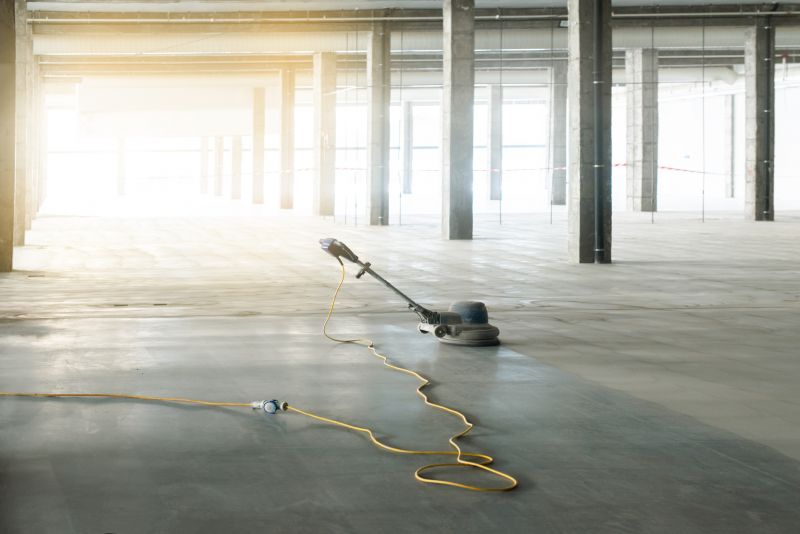Top-Rated Products For Concrete Floor Refinishings To Enhance Durability
Explore trusted products that provide long-lasting protection and a polished finish for your concrete surfaces.
 Refinishing concrete floors is a practical way to enhance the durability and appearance of existing surfaces in residential, commercial, or industrial settings. The process typically involves cleaning the surface thoroughly to remove debris, oils, and previous coatings, followed by surface preparation such as grinding or etching to create a suitable profile for new coatings. Applying a high-quality sealant or coating can restore the floor's integrity, improve its aesthetic appeal, and extend its lifespan. Depending on the desired finish, options range from smooth, glossy surfaces to textured or matte appearances.
Refinishing concrete floors is a practical way to enhance the durability and appearance of existing surfaces in residential, commercial, or industrial settings. The process typically involves cleaning the surface thoroughly to remove debris, oils, and previous coatings, followed by surface preparation such as grinding or etching to create a suitable profile for new coatings. Applying a high-quality sealant or coating can restore the floor's integrity, improve its aesthetic appeal, and extend its lifespan. Depending on the desired finish, options range from smooth, glossy surfaces to textured or matte appearances.
Top Overall Option
High-Performance Concrete Coating System
A versatile and durable coating system designed for a variety of concrete surfaces, offering strong adhesion, chemical resistance, and a range of finish options. Suitable for both residential and commercial applications, it provides a reliable solution for restoring and protecting concrete floors over time.
Types of Products For Concrete Floor Refinishings
Epoxy Floor Coatings
Epoxy coatings create a hard, glossy surface that resists stains and wear, ideal for garages and industrial spaces.
Concrete Sealers
Sealers provide a protective layer that guards against moisture and staining, enhancing durability.
Concrete Stains
Stains add color and decorative effects to concrete surfaces, offering a wide range of hues and patterns.
Overlay Mortars
Overlay mortars are used to repair and level uneven or damaged concrete surfaces before refinishing.
Patching Compounds
Patching compounds help repair cracks, holes, and surface imperfections for a smooth finish.
Polyurethane Coatings
Polyurethane coatings offer high flexibility and chemical resistance for demanding environments.
Acrylic Sealers
Acrylic sealers are easy to apply and provide a clear protective layer with a matte or gloss finish.
Grinding and Polishing Tools
Tools for surface preparation that help achieve a smooth, polished finish on concrete floors.
Etching Solutions
Chemical etching prepares the concrete surface for coatings by creating a rough texture.
Decorative Flakes and Chips
Add decorative flakes or chips to coatings for textured, visually appealing finishes.
Self-Leveling Compounds
Self-leveling compounds create smooth, even surfaces over uneven concrete floors.
Vapor Barriers
Vapor barriers prevent moisture transmission, protecting refinished floors from damage.
Anti-Slip Additives
Additives that improve traction and safety on polished or sealed concrete surfaces.
Bonding Agents
Primers that enhance adhesion between existing concrete and new coatings or overlays.
Popular Choices
Widely used for their durability and glossy finish, suitable for various high-traffic areas.
Commonly selected for protecting concrete surfaces from stains and moisture.
Favored for decorative purposes, offering a range of vibrant colors and effects.
Often used to create a smooth base before applying other coatings or overlays.
Chosen for their high-performance qualities in demanding environments.
Easy-to-apply options that provide a clear protective layer with various finishes.
Frequently used to repair surface imperfections before refinishing.
Popular for adding texture and visual interest to coated floors.
Essential for preparing concrete surfaces for finishing or polishing.
Commonly used to prevent moisture issues in basement or ground-level floors.
Popular for safety enhancements, especially in wet or high-traffic areas.
Various products are available to facilitate different refinishing needs, including epoxy coatings, concrete stains, sealers, overlays, and patching compounds. Epoxy coatings are popular for their strong adhesion and chemical resistance, making them suitable for high-traffic areas. Concrete stains provide a decorative touch by adding color and patterns, while sealers protect the surface from moisture and staining. Overlays and patches help repair damaged areas, creating a uniform base for further finishing. Selecting the right product depends on the specific condition of the floor, the intended use, and aesthetic preferences.
Proper application techniques are crucial for achieving optimal results. This may involve using brushes, rollers, or sprayers, depending on the product type. Adequate drying and curing times are essential to ensure durability and adhesion. Regular maintenance, including cleaning and re-sealing as needed, can help preserve the refinished surface over time. Consulting product instructions and considering professional assistance for complex projects can lead to more satisfactory outcomes. Overall, investing in the right products and techniques can significantly improve the functionality and look of concrete floors, making them suitable for a variety of environments.
Key Buying Considerations
- Determine the condition of the existing concrete surface to select appropriate products.
- Identify the intended use of the space to choose suitable coatings or sealants.
- Consider the level of foot traffic and wear to select durable and resistant products.
- Evaluate the desired aesthetic finish—glossy, matte, textured, or decorative.
- Check compatibility of products with existing surfaces and previous coatings.
- Review drying and curing times to plan application schedules accordingly.
- Assess ease of application based on your skill level and available tools.
- Look for products with good adhesion properties to ensure long-lasting results.
- Consider moisture levels in the environment to select proper sealers or vapor barriers.
- Factor in maintenance requirements for ongoing care and re-coating needs.
- Examine safety instructions, especially for chemical-based products.
- Determine if surface preparation tools are needed, such as grinders or etchers.
- Plan for repair materials like patching compounds for damaged areas.
- Budget for the project, including products, tools, and possible professional assistance.
- Read product reviews and ratings for insights into performance and user satisfaction.
